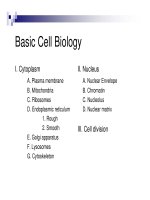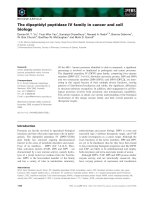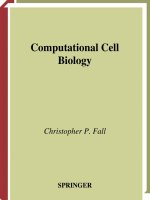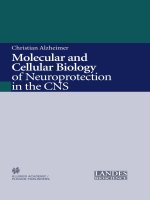Schaums easy outline molecular and cell biology william stansfield, raul j cano, jaime s colome
Bạn đang xem bản rút gọn của tài liệu. Xem và tải ngay bản đầy đủ của tài liệu tại đây (2.25 MB, 129 trang )
SCHAUM’S Easy OUTLINES
MOLECULAR AND
CELL BIOLOGY
Other Books in Schaum’s
Easy Outlines Series Include:
Schaum’s Easy Outline: Calculus
Schaum’s Easy Outline: College Algebra
Schaum’s Easy Outline: College Mathematics
Schaum’s Easy Outline: Discrete Mathematics
Schaum’s Easy Outline: Differential Equations
Schaum’s Easy Outline: Elementary Algebra
Schaum’s Easy Outline: Geometry
Schaum’s Easy Outline: Linear Algebra
Schaum’s Easy Outline: Mathematical Handbook
of Formulas and Tables
Schaum’s Easy Outline: Precalculus
Schaum’s Easy Outline: Probability and Statistics
Schaum’s Easy Outline: Statistics
Schaum’s Easy Outline: Trigonometry
Schaum’s Easy Outline: Business Statistics
Schaum’s Easy Outline: Principles of Accounting
Schaum’s Easy Outline: Principles of Economics
Schaum’s Easy Outline: Biology
Schaum’s Easy Outline: Biochemistry
Schaum’s Easy Outline: College Chemistry
Schaum’s Easy Outline: Genetics
Schaum’s Easy Outline: Human Anatomy
and Physiology
Schaum’s Easy Outline: Organic Chemistry
Schaum’s Easy Outline: Physics
Schaum’s Easy Outline: Applied Physics
Schaum’s Easy Outline: Programming with C++
Schaum’s Easy Outline: Programming with Java
Schaum’s Easy Outline: Basic Electricity
Schaum’s Easy Outline: Electromagnetics
Schaum’s Easy Outline: Introduction to Psychology
Schaum’s Easy Outline: French
Schaum’s Easy Outline: German
Schaum’s Easy Outline: Spanish
Schaum’s Easy Outline: Writing and Grammar
SCHAUM’S Easy OUTLINES
MOLECULAR AND
CELL BIOLOGY
Based on Schaum’s
O u t l i n e o f T h e o r y a n d P ro b l e m s o f
Molecular and Cell Biology
b y W i l l i a m D . S t a n s f i e l d , Ph.D.
J a i m e S . C o l o m é , Ph.D.
R a ú l J . C a n o , Ph.D.
Abridgement Editor
K a t h e r i n e E . C u l l e n , Ph.D.
SCHAUM’S OUTLINE SERIES
M c G R AW - H I L L
New York Chicago San Francisco Lisbon London Madrid
Mexico City Milan New Delhi San Juan
Seoul Singapore Sydney Toronto
Copyright © 2003 by The McGraw-Hill Companies, Inc. All rights reserved. Manufactured in the United States of
America. Except as permitted under the United States Copyright Act of 1976, no part of this publication may be reproduced or distributed in any form or by any means, or stored in a database or retrieval system, without the prior written permission of the publisher.
0-07-142586-1
The material in this eBook also appears in the print version of this title: 0-07-139881-3.
All trademarks are trademarks of their respective owners. Rather than put a trademark symbol after every occurrence of a trademarked name, we use names in an editorial fashion only, and to the benefit of the trademark owner,
with no intention of infringement of the trademark. Where such designations appear in this book, they have been
printed with initial caps.
McGraw-Hill eBooks are available at special quantity discounts to use as premiums and sales promotions, or for
use in corporate training programs. For more information, please contact George Hoare, Special Sales, at
or (212) 904-4069.
TERMS OF USE
This is a copyrighted work and The McGraw-Hill Companies, Inc. (“McGraw-Hill”) and its licensors reserve all
rights in and to the work. Use of this work is subject to these terms. Except as permitted under the Copyright Act
of 1976 and the right to store and retrieve one copy of the work, you may not decompile, disassemble, reverse engineer, reproduce, modify, create derivative works based upon, transmit, distribute, disseminate, sell, publish or sublicense the work or any part of it without McGraw-Hill’s prior consent. You may use the work for your own noncommercial and personal use; any other use of the work is strictly prohibited. Your right to use the work may be
terminated if you fail to comply with these terms.
THE WORK IS PROVIDED “AS IS”. McGRAW-HILL AND ITS LICENSORS MAKE NO GUARANTEES OR
WARRANTIES AS TO THE ACCURACY, ADEQUACY OR COMPLETENESS OF OR RESULTS TO BE
OBTAINED FROM USING THE WORK, INCLUDING ANY INFORMATION THAT CAN BE ACCESSED
THROUGH THE WORK VIA HYPERLINK OR OTHERWISE, AND EXPRESSLY DISCLAIM ANY WARRANTY, EXPRESS OR IMPLIED, INCLUDING BUT NOT LIMITED TO IMPLIED WARRANTIES OF MERCHANTABILITY OR FITNESS FOR A PARTICULAR PURPOSE. McGraw-Hill and its licensors do not warrant
or guarantee that the functions contained in the work will meet your requirements or that its operation will be uninterrupted or error free. Neither McGraw-Hill nor its licensors shall be liable to you or anyone else for any inaccuracy, error or omission, regardless of cause, in the work or for any damages resulting therefrom. McGraw-Hill has
no responsibility for the content of any information accessed through the work. Under no circumstances shall
McGraw-Hill and/or its licensors be liable for any indirect, incidental, special, punitive, consequential or similar
damages that result from the use of or inability to use the work, even if any of them has been advised of the possibility of such damages. This limitation of liability shall apply to any claim or cause whatsoever whether such claim
or cause arises in contract, tort or otherwise.
DOI: 10.1036/0071425861
For more information about this title, click here.
Contents
Chapter 1
Chapter 2
Chapter 3
Chapter 4
Chapter 5
Chapter 6
Chapter 7
Chapter 8
Chapter 9
Chapter 10
Chapter 11
Chapter 12
Index
Cells
1
Biomolecules
18
Chromosomes
30
Transcription and Gene Regulation 41
Translation
53
Mutations
60
Bacterial Genetics and
Bacteriophages
67
Recombinant DNA Technology
73
Nucleic Acid Manipulations
81
Eukaryotic Viruses
90
Cell Communication
98
Molecular Evolution
105
118
v
Copyright 2003 by The McGraw-Hill Companies, Inc. Click Here for Terms of Use.
This page intentionally left blank.
Chapter 1
Cells
In This Chapter:
✔
✔
✔
✔
✔
Introduction
Cellular Organization
Metabolism
Reproduction
Solved Problems
Introduction
A cell is the smallest unit that exhibits all of the
qualities associated with the living state. Cells must
obtain energy from an external source to carry on
such vital processes as growth, repair, and reproduction. All of the chemical and physical reactions
that occur in a cell to support these functions constitute its metabolism. Metabolic reactions are catalyzed by enzymes. Enzymes are protein molecules
that accelerate biochemical reactions without being permanently altered
or consumed in the process. The structure of each enzyme (or any other
protein) is encoded by a segment of a deoxyribonucleic acid (DNA) molecule referred to as a gene.
Molecular and cell biology are the sciences that study all life
processes within cells and at the molecular level. In doing so, these sci-
1
Copyright 2003 by The McGraw-Hill Companies, Inc. Click Here for Terms of Use.
2 MOLECULAR AND CELL BIOLOGY
ences draw upon knowledge from several scientific disciplines, including biochemistry, cytology, genetics, microbiology, embryology, and
evolution.
Cellular Organization
Structurally, there are two basic kinds of cells: prokaryotic and eukaryotic. Prokaryotic cells, including bacteria and archae, although far from
simple, are generally much smaller and less complex structurally than eukaryotic cells. The major difference is that the genetic material (DNA) is
not sequestered within a double-membrane structure called a nucleus
(see Figure 1-1). In eukaryotes, a complete set of genetic instructions is
found on the DNA molecules, which exist as multiple linear structures
called chromosomes that are confined within the nucleus.
Eukaryotic cells also contain other membrane-bound organelles
within their cytoplasm (the region between the nucleus and the plasma
membrane). These subcellular structures vary tremendously in structure
and function.
Most eukaryotic cells have mitochondria, which contain the enzymes and machinery for aerobic respiration and oxidative phosphorylation. Thus, their main function is generation of adenosine triphosphate
(ATP), the primary currency of energy exchanges within the cell. This organelle is bounded by a double membrane. The inner membrane, which
houses the electron transport chain and the enzymes necessary for ATP
synthesis, has numerous foldings called cristae, which protrude into the
matrix, or central space. Mitochondria contain their own DNA and ribosomes, but most of their proteins are imported from the cytoplasm.
You Need to Know
Mitochondria are nicknamed the “powerhouses” of
the cell because of their role in ATP production.
Chloroplasts contain the photosynthetic systems for utilizing the radiant energy of sunlight and are found only in plants and algae. Photo-
CHAPTER 1: Cells
Figure 1-1 An animal cell.
3
4 MOLECULAR AND CELL BIOLOGY
synthesis is the process that converts light energy into the chemical bond
energy of ATP, which in turn can be used to convert carbon dioxide (CO2)
and water (H2O) into carbohydrates. Chloroplasts contain an internal system of membranes called thylakoids, a circular chromosome, and their
own ribosomes. The flattened, vesicular thylakoids contain the chlorophyll pigments, the enzymes, and other molecules needed to harness light
energy for conversion to chemical energy. Carbon fixation occurs in the
stroma, the space between the thylakoids and the inner membrane.
Prokaryotic cells lack internal membranes, but photosynthetic bacteria contain invaginations of the plasma membrane called mesosomes.
Centrioles, located within the centrosome, are associated with the
cell’s polar regions, toward which the chromosomes migrate during cell
division, and are found only in animal cells. The endoplasmic reticulum
(ER) amplifies the surface area available for specialized biochemical reactions and the synthesis of certain types of proteins. The Golgi complex
directs the transport of proteins and other biomolecules to specific locations within the cell. Vacuoles serve as storage compartments for food,
water, or other molecules. Enzymes digest materials brought into the cell
within lysosomes.
Ribosomes function in the manufacture of proteins. The ribosomes
in prokaryotes are smaller than those found in the cytoplasm in eukaryotes, but are similar in size and structure to those found in the mitochondria and chloroplasts of eukaryotes. Eukaryotic ribosomes associated
with the ER give it a granular appearance, hence the name rough ER.
Remember
Proteins that are:
1. membrane bound
2. secreted
3. compartmentalized
are synthesized on the ER.
CHAPTER 1: Cells
5
Motility is accomplished by different means in prokaryotic and eukaryotic cells. Eukaryotic cells, such as amoebas and white blood cells,
creep along substrates as an undulating mass of constantly changing morphology. This type of motion is achieved by a massive network of protein
fibers, the cytoskeleton. Motile bacteria are usually propelled by one or
more hairlike appendages called flagella that originate in the plasma membrane and rotate like propellar shafts (see Figure 1-2). These filaments are
constructed of the protein flagellin. Some eukaryotic cells also have flagella, but they consist of bundles of microtubules made of tubulin, and
they originate from a basal body in the cytoplasm. Eukaryotic flagella
such as those in sperm tails bend back and forth in quasi-sinusoidal waves.
Eukaryotic cilia are structurally similar but are much shorter, more numerous, and more rigid on the powerstroke. Some bacteria also have long
hollow tubes called pili or fimbriae composed of a protein called pilin.
These structures do not contribute to motility, but to the adhesiveness of
bacteria and the facilitation of conjugation (see Chapter 7).
One of the distinguishing features between plants and animals is that
plants and fungi have cell walls made of cellulose and chitin, respectively, but animal cells do not. Almost all bacteria have a rigid cell wall surrounding the plasma membrane, but it has a different structure than the
plant cell wall and is composed of peptidoglycan. Some bacteria also
have a polysaccharide capsule or a glycocalyx surrounding the cell wall.
Figure 1-2 A bacterial cell.
6 MOLECULAR AND CELL BIOLOGY
These protect the bacteria from predatory cells and promote their attachment to various objects and to each other. Most eukaryotic cells also have
a glycocalyx that covers the surface of the cell and promotes cell adhesions in the formation of specific tissues. In addition, many types of animal cells are surrounded by an extracellular matrix, which comprises a
variety of proteins that give specific tissues their characteristic properties.
Metabolism
The two major carbon sources utilized by cells to synthesize organic molecules are (1) complex organic molecules, such as sugars and amino
acids, and (2) single-carbon compounds, such as CO2 or methane (CH4).
Cells that use CO2 as their sole source of carbon are called autotrophs,
and cells that require complex organic compounds are referred to as
heterotrophs. Cells that can obtain energy from light are called phototrophs, and cells that require chemical energy are called chemotrophs.
Try it!
Distinguish between a photoautotroph and a
photoheterotroph or a chemoautotroph and a
chemoheterotroph.
Glycolysis is a nearly universal process in which the six carbon
sugar glucose is anaerobically converted, through a series of enzymatically catalyzed steps in the cytosol, the fluid portion of the cytoplasm,
into two molecules of the three carbon compound pyruvate. Two molecules of ATP are expended early on in glycolysis, but four more are generated later by substrate-level phosphorylation. Thus, there is a net production of two ATP molecules per molecule of glucose. In addition, two
molecules of nicotinamide adenine dinucleotide (NAD) become reduced by gaining two electrons.
CHAPTER 1: Cells
7
Remember Glycolysis!
Glucose + 2 NAD+ + 2 ADP + 2 Pi r
2 pyruvate + 2 ATP + 2 NADH + H+
Either fermentation or respiration may follow glycolysis (see Figure
1-3). Fermentation is an oxygen-independent process, occuring in the
cytosol, which uses organic molecules as terminal electron acceptors.
Fermentation regenerates the supply of NADϩ for glycolysis and results
in the consumption of pyruvate and the release of molecules such as CO2
or H2 (gases); lactic, formic, acetic, succinic, butyric, or propionic acids;
and ethanol, butanol, or propanol (alcohols). The final product depends
on the species. No additional ATP is generated during fermentation.
Note!
Many of the waste products of fermentation are
valuable commercial products!
Respiration involves the oxidation of molecules, the generation of
high-energy molecules, such as ATP, by passing pairs of electrons (and
hydrogen ions, or protons) through an electron transport system, and the
donation of these electrons to an inorganic electron acceptor. If the terminal electron acceptor is oxygen, this process is termed aerobic respiration. Anerobic respiration occurs when the terminal electron acceptor is an inorganic molecule other than molecular oxygen (such as sulfate
or nitrate). Organisms vary in their oxygen requirements; some are strict
anaerobes and cannot survive in the presence of oxygen. Facultative
anaerobes can respire aerobically or anaerobically, and obligate aerobes
require oxygen for survival.
Pyruvate generated from glycolysis in the cytosol may enter the mitochondria and, if oxygen is available, be enzymatically converted to
acetyl coenzyme A (acetyl CoA) and CO2. Within the matrix of the mitochondria or the cytosol of aerobic prokaryotes, the two-carbon acetyl CoA
8 MOLECULAR AND CELL BIOLOGY
Figure 1-3 Chemoheterotrophic metabolism.
CHAPTER 1: Cells
9
enters a circular set of enzymatic reactions known as the Krebs cycle, the
tricarboxylic acid cycle (TCA), or the citric acid cycle (see Figure 1-3).
During oxidation of a substrate, two major electron carriers, NAD+
and FAD, become reduced to NADH and FADH2. One complete turn of
the TCA produces three molecules of NADH, two molecules of CO2, one
molecule of FADH2, and one molecule of guanosine triphosphate
(GTP). The electrons and H+ ions from NADH and FADH2 are transferred to the electron transport chains within the cristae of the mitochondria or the plasma membrane of prokaryotes. These chains consist of series of proteins that first serve as electron acceptors, then donors to the
next complex in the chain. This series of coupled oxidations and reductions results in the terminal tranfer of electrons and H+s to oxygen, forming water as the end product.
The complete oxidation of glucose:
C6H12O6 + 6O2 r 6CO2 + 6H2O
ATP can be generated by three different mechanisms. It can be
formed from adenosine diphosphate (ADP) by either substrate-level
phosphorylation or oxidative phosphorylation. In substrate-level phosphorylation, an enzyme mediates the transfer of a phosphate group from
a phosphorylated organic molecule to ADP. Oxidative phosphorylation
occurs when molecules are oxidized and energy is extracted from the
electrons by passing them through an electron transport system, where
most of the resulting free enrgy is used to drive the phosphorylation of
ADP, producing ATP. Photophosphorylation also synthesizes ATP, but
uses the energy from sunlight rather than from the breakdown of organic molecules.
Reproduction
Most cells reproduce asexually, without exchanging or acquiring new
hereditary information. Bacteria reproduce almost exclusively in this
fashion in a process called binary fission, during which the bacterium
grows, duplicates its hereditary information, segregates the duplicated
chromosome, and divides the cytoplasm. Most cells that form the bodies
10 MOLECULAR AND CELL BIOLOGY
of multicellular eukaryotes are also produced asexually in a process
termed mitosis. During mitotic division, the cells grow, duplicate their
genomes, separate their duplicated chromosome sets into nuclei at the opposite poles of the cell, and divide the cytoplasm to form progeny cells.
The eukaryotic cell cycle contains four major phases (see Figure
1-4). The S phase is when DNA synthesis occurs to replicate the chromosomes by creating identical sister chromatids. The period between S
phase and the beginning of mitosis (M phase) is a gap, or growth period,
designated G2 phase. Another gap or growth period called the G1 phase,
occurs between the M and S phases to complete the cycle.
Mitosis consists of four consecutive phases: prophase, metaphase,
anaphase, and telophase (see Figure 1-5). During prophase, each chromosome shortens and thickens by supercoiling on itself again and again.
Figure 1-4 Eukaryotic cell cycle.
11
Figure 1-5 Mitosis in animal cells.
12
Figure 1-5 Mitosis in animal cells, continued.
CHAPTER 1: Cells
13
The nuclear membrane dissolves, and a spindle of microtubules forms
from one pole of the cell to the other. During metaphase, the chromosomes line up in the center of the spindle. At anaphase, the two chromatids of each replicated chromosome are pulled to opposite poles by depolymerization of the microtubules in the spindle apparatus that are
attached to the centromeres. These former sister chromatids are now considered to be new chromosomes. Division of the cytoplasm (cytokinesis)
begins in telophase, as the chromosomes unwind and new nuclear membranes form to enclose the sets of chromosomes at each pole of the cell.
When mitosis is completed, two progeny cells contain identical sets of
chromosomes.
The somatic cells of most plants and animals are diploid, meaning
they have two sets of homologous chromosomes. One set is derived from
each parent through the gametes that produced the zygote from which the
organism developed. The process of meiosis reduces the chromosome
number from diploid to haploid in gametes, or sex cells; thus, each parent contributes an equal number of chromosomes to their offspring.
You Need to Know
Meiosis I is reductional division, since the number of chromosomes is reduced; meiosis II is equational division.
The predominant form of reproduction in most multicellular eukaryotes is sexual. At sexual maturity, some diploid germ line cells become specialized to undergo meiosis and form haploid gametes. Meiosis
can be visualized as two highly modified cell cycles, back to back (see
Figure 1-6). A complete meiotic cycle involves one initial DNA replication and two cytoplasmic divisions, yielding four haploid products, none
of which are genetically identical. The two cycles are labeled meiosis I
and II, each of which has its own prophase, metaphase, anaphase, and
telophase.
The major events of these phases mirrors the events during mitosis.
However, during prophase I of meiosis, homologous chromosomes pair
Figure 1-6 Meiosis in plant cells.
Figure 1-6 Meiosis in plant cells, continued.
16 MOLECULAR AND CELL BIOLOGY
up in a process called synapsis. A synapsed pair of chromosomes contains four chromatids. Each chromosome usually has one or more regions
in which two of the four chromatids break at corresponding sites and reunite with one another, a process called crossing over, which increases
genetic variability. During anaphase I, the homologous chromosomes are
separated, yielding two haploid cells at the completion of the first stage
of meiosis. During anaphase II, sister chromatids are separated, as they
are during mitotic anaphase. The end result is four genetically different
haploid cells.
Solved Problems
Solved Problem 1.1 Aside from DNA and certain associated proteins in
chromosomes, what macromolecular aggregates are shared by all prokaryotes and eukaryotes?
Both prokaryotic and eukaryotic cells possess a lipid plasma membrane that separates a cell from its environment. In addition, all cells have
ribosomes, made partly of protein and partly of ribonucleic acid (RNA)
molecules. Ribosomes function in the synthesis of proteins.
Solved Problem 1.2 How are chloroplasts and mitochondria structurally similar?
They both are surrounded by an inner and outer membrane, a means
for increasing the area of their membrane systems, contain their own circular chromosome, and have their own ribosomes.
Solved Problem 1.3 Why can’t H2S or NH3 act as terminal electron acceptors in anaerobic respiration?
H2S and NH3 are both already completely reduced.
Solved Problem 1.4 What would you expect to happen if a facultative
anaerobe were grown in the presence of oxygen and glucose?
If oxygen is present for aerobic respiration, fermentation essentially
ceases, the rate of glucose consumption decreases, and the rate of acid
CHAPTER 1: Cells
17
and/or alcohol production is inhibited. This phenomenon is known as the
Pasteur effect.
Solved Problem 1.5 What occurs in meiosis, but not mitosis?
Synapsis, crossing over, and separation of homologous chromosomes happen during meiosis, but not mitosis.
Chapter 2
Biomolecules
In This Chapter:
✔
✔
✔
✔
✔
Carbohydrates
Lipids
Proteins
Nucleic Acids
Solved Problems
Carbohydrates
Pure carbohydrates have the empirical formula
(CH2O)n. The smallest carbohydrates are simple
sugars, or monosaccharides. Glucose is the sixcarbon monosaccharide (hexose) used as a basic
source of energy by most heterotrophic cells. Ribose and deoxyribose are the five-carbon sugars (pentoses) that serve a
structural role in the nucleic acids RNA and DNA, respectively. Oligosaccharides are small polymers of two to six monosaccharides. Sucrose
is a disaccharide of the two monosaccharides glucose and fructose (an
isomer of glucose). Sucrose is the major sugar transported between plant
cells, whereas glucose is the primary sugar transported between animal
cells. Lactose, the major sugar in milk, is a disaccharide of glucose and
galactose (an epimer of glucose). Most of the carbohydrate molecules in
18
Copyright 2003 by The McGraw-Hill Companies, Inc. Click Here for Terms of Use.









